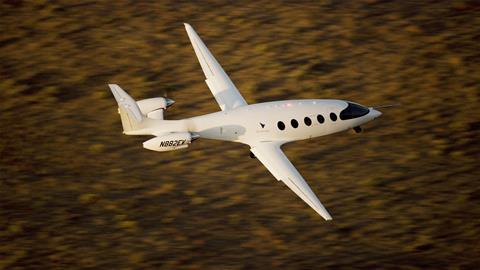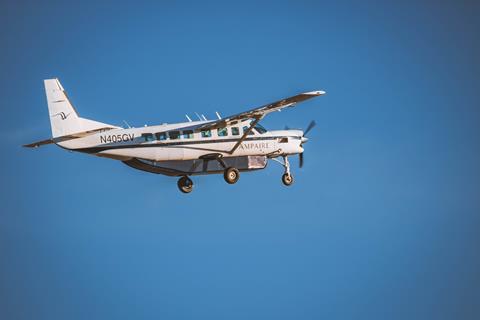Companies seeking to re-envision regional flight could connect communities lacking air service and tap into a potentially lucrative market.
But that outcome remains far from a given, especially considering factors such as the need for highly expensive new airport infrastructure and far better batteries.
A recent report from management consultancy McKinsey estimates the market for regional air mobility (RAM) could reach as high as $115 billion by 2035. But the report, released 31 May, also identifies challenges the sector must overcome before realising a renaissance of short-haul passenger flights.
“While there is excitement about the opportunity, there is also worry about, ‘Can we actually get there?’” Robin Riedel, who co-leads the McKinsey Center for Future Mobility and co-authored the study, tells FlightGlobal on 5 June.

Whereas many electric vertical take-off and landing (eVTOL) start-ups are developing aircraft for flying up to four passengers from city centres to major airports, the separate RAM segment is focused on conventional short-haul routes between 150km (81nm) and 800km, using existing airports and developing aircraft capable of flying five to 50 passengers.
More than 50 RAM companies worldwide are ”developing battery-electric, hybrid and hydrogen power trains; new and retrofitted aircraft designs; advanced avionics; operations and booking platforms; and other important enablers of the RAM ecosystem”, McKinsey says.
For example, Australian advanced powerplant developer Dovetail Electric Aviation is working to electrify the existing fleet of regional turboprops. And California start-up Xwing is developing technology it says will allow for autonomous aircraft – including types larger than turboprops – to safely integrate into national airspace.
The sector has attracted more than $1 billion of investments. Proponents say embracing low- or no-emissions propulsion technologies such as electric and hydrogen-fuelled systems could revitalise regional air service, which is contracting amid an ongoing pilot shortage and an environment of high operating costs.
“Technology is getting to the point where [operators] can actually reduce costs, whether that is by novel propulsion, better designs of aircraft, autonomy or augmentation of flight crews,” Riedel says.
But there are significant obstacles ahead, including the cost of new airport infrastructure to support electric charging and hydrogen fuelling, McKinsey warns: ”A typical regional airport serving 200,000 passengers annually could require $6 million in investment for charging or fuelling.”
RAM’s prospects also depend on “continuous technological advances” such as increased battery energy density, according to McKinsey.
”Battery energy density will need to at least double today’s density for the RAM market to meet its full potential,” the report says. ”Similarly, hydrogen fuel cells are at an early stage of maturity and further advances will be critical to RAM’s growth…. Hybrid power trains are nearer to commercialisation and will play an important role.”
‘HAPPENS TO BE ELECTRIC’
RAM companies see a relatively untapped market with thousands of small and mid-sized regional airports sitting underused across the USA. They also claim their aircraft have a clearer path to commercialisation than do eVTOLs, which face more-uncertain certification standards, unclear integration into existing air traffic management systems and may require expensive new operating infrastructures.
US regional air mobility companies such as Eviation, which is developing an all-electric nine-seat commuter aircraft called Alice, tout that their aircraft do not require new standards for certification and air traffic control, or new airport infrastructure – unlike eVTOLs, which require “vertiports” for take-off and landing.
In many ways, Alice “is just an airplane that happens to be electric”, chief executive Greg Davis told FlightGlobal during McKinsey’s 24 February Regional Air Mobility Summit in San Francisco. “I think we found the sweet spot for electric aviation. It is a commuter-category plane, which means that we’re going to certify it using existing standards and regulations.”
Eviation has flown Alice – a clean-sheet, fixed-wing electric aircraft that looks the part of a commuter – but only once, in September 2022, and has not disclosed further flight-test operations in the roughly eight months since.
Based in Washington state, Eviation has said it intends to start certification test flights in 2025 and to start delivering Alice in 2027.
Powered by twin Magnix 700kW Magni650 motors, Alice is designed to fly at speeds up to 260kt (482km/h) and have about 250nm (463km) of range in visual flight conditions, with 30min of reserve range. Alice lends itself to the commuter model because its nine-seat capacity is the upper threshold for single-pilot operations.
“With the pilot shortage, the cost of pilots is high,” Davis says. “And, of course, electricity is so much cheaper than jet fuel.”
“You put those things together, and then you have an airplane that can fly from existing airports, through existing airspace, using existing regulations… I mean, it is just the clearest path for how we are going to do this,” he says.
’ONE IMPORTANT, HARD PROBLEM’
As eVTOL companies are rolling out Jetsons-type visions of air taxis flying over major cities, other start-ups seeking to modify existing aircraft believe they have the edge in the race to reduce aviation emissions.
For example, propulsion system developer Ampaire has flown a Cessna Grand Caravan modified to run on a new hybrid-electric powerplant. It consists of a Red Aircraft piston engine, an electric motor and batteries supplied by Electric Power Systems – all replacing the Caravan’s stock Pratt & Whitney Canada PT6 turboprop.
The company hopes to secure Federal Aviation Administration approval for the modification via a supplemental type certificate in 2024.

Kevin Noertker, co-founder and CEO of Ampaire, says his company’s hybrid-electric system serves as a half-step to fully electric regional aviation.
“The issue I see is that a lot of people try to take a full step with new technology – clean-sheet aircraft that have vertical take-off and landing or can land in the space of a parking lot, or require wild upgrades to the entire infrastructure of the country,” he says. “It is very difficult to achieve anything new in aviation. How many Nobel Prizes do you need to gain along the path to commercialisation?”
Ampaire is taking a more modest approach, with Noertker hoping to “to make a little dent on the world” by focusing on “one really important, hard problem”. He views hybrid-electric propulsion as low-hanging fruit to help the aviation industry reach its emissions-reduction targets without the risks associated with developing novel aircraft.
“Upgrading existing airplane types is very efficient relative to a new airplane type,” he says. Ampaire’s Cessna “Eco” Grand Caravan burns about half as much fuel as conventional Caravans, providing immediate CO2 emission reductions and cost savings, he says.
The start-up’s longer-term goal is for Cessna parent Textron Aviation to offer Ampaire’s hybrid-electric propulsion systems in aircraft right off the factory line. But Ampaire must prove the safety and reliability of its technology and establish a market before OEMs will take notice, Noertker acknowledges.
“The up-front cost of our system is less than the PT6 we’re replacing, so this is an economically viable up-front purchase, [and has] better economics on operations,” he says. “Now you can start to do some meaningful things with the market – you can either improve profitability of existing routes, open up new routes that have atrophied, or even drive additional feeder routes into [San Francisco] or [Los Angeles] or other major hubs.”
Conventional aircraft retrofitted with hybrid-propulsion systems would use existing airports and not require new infrastructure, which Noertker views as potential pitfalls for all-electric and hydrogen aircraft.
“I’m worried that, whether it is the energy infrastructure, investment for megawatt charging…. that the economics are going to be very challenging along the way for some of these peer solutions,” he says.
GRIDLOCK AND ’HASSLE FACTORS’
Regional air mobility could benefit from increasingly congested highways, particularly in the USA but also globally, diminishing the convenience of driving as a regional transit option.
”In nearly 40% of US metro areas, traffic was worse in 2022 than pre-pandemic, and more than 200 major airports worldwide are capacity constrained, underscoring the unmet demand for transportation that avoids congested roads and major airports,” McKinsey says.
Ultra-low-cost carriers are increasingly playing the role of regional airlines, with narrowbody operators filling some routes between secondary cities. ”Although air travel for trips between 150km and 800km has increased in recent years…. much of this growth was driven by low-cost carriers using larger aircraft,” McKinsey says.
But with larger aircraft come larger airports – and more hassle. Convenience is a top consideration for RAM companies, whose executives are aware that many potential customers would rather drive than take short-haul flights from major airports.
Some in the sector are looking to ride-sharing apps for inspiration as they attempt to create ”end-to-end” journeys that smoothly link passengers’ first and last miles, Riedel says. Regional air travel company Surf Air Mobility – another player seeking to electrify existing turboprops – is working to further develop its app-based booking platform, which allows passengers to book flights with third-party operators.
”The whole question of, ’How we make this easy to use, intuitive, seamless – or minimise the seams as much as we can?’ is the big challenge that is going to make or break this industry,” Riedel says.
He envisions a “terminal in a box that provides both digital and physical infrastructure to handle passengers” at regional airports. But matching the convenience of roadside ride-sharing apps will be challenging, he adds, as those services need not account for airport security checks and infrastructure.
“If you have to show up 20 minutes early and put your bags through something and go through security and take your shoes off – I am pretty sure most people would prefer to drive, even if it is a little bit longer,” he says.
Much rides on creating a product that beats driving, Riedel says: “Can we as an industry figure out how to make this easy? There are thousands of airports available for this, but how do you really unlock them?”






























